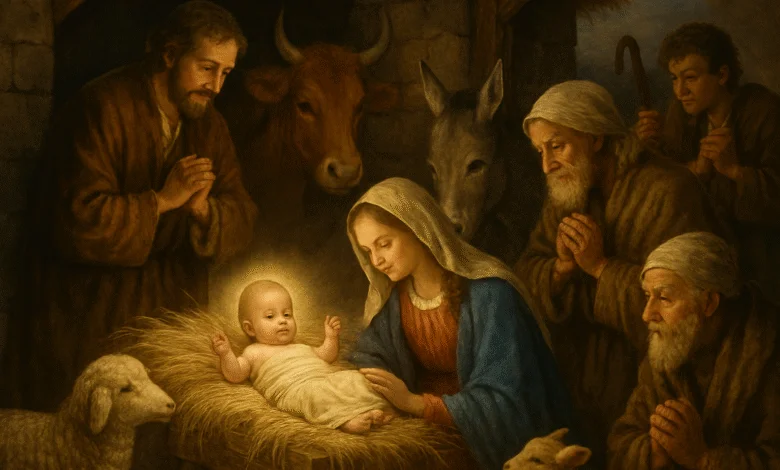Nativität is a concept that transcends mere definition. It embodies the profound essence of birth, renewal, and spiritual awakening found in various religious traditions. As we delve into this rich tapestry of meanings, we’ll explore how Nativität serves as a powerful symbol across cultures and faiths. From ancient rituals to modern celebrations, understanding Nativität invites us to reflect on our shared humanity and the cycles of life that connect us all. Join us on this enlightening journey as we uncover the historical roots, symbolism, and enduring legacy of Nativität in both art and culture.
What Does Nativität Mean?
Nativität, derived from the Latin word “nativitas,” translates to “birth” or “nativity.” It signifies not just the act of being born but also embodies the spiritual significance tied to new beginnings.
In many religious contexts, Nativität represents divine intervention and the manifestation of hope. This concept is celebrated as a moment when light enters into darkness, symbolizing transformation.
The term resonates deeply in Christianity, particularly associated with the birth of Jesus Christ. However, its influence extends far beyond one faith tradition, encompassing various interpretations across different cultures and beliefs around the world.
Historical Roots of Nativität
The concept of Nativität has its roots in ancient religious traditions. It signifies the birth or nativity, often associated with divine intervention and significant events.
In Christianity, it specifically refers to the Nativity of Jesus Christ, celebrated during Christmas. This event marked a pivotal moment in history, symbolizing hope and redemption for humanity.
Other cultures also embrace similar themes surrounding birth. From ancient rituals to modern celebrations, the essence of Nativität remains an integral part of understanding life’s cycles and spiritual significance across diverse faiths.
Nativität in Religious Contexts
Nativität holds profound significance across various religious traditions. In Christianity, it symbolizes the birth of Jesus Christ, celebrated during Christmas. This event signifies hope and divine love entering the world.
In Hinduism, Nativität is reflected in stories like that of Lord Krishna’s birth, representing joy and spiritual awakening. Celebrations often include rituals that highlight family bonding and community spirit.
Buddhism acknowledges the importance of birth through Siddhartha Gautama’s early life. His journey from prince to enlightened being emphasizes transformation and understanding life’s impermanence. Each tradition enriches our understanding of Nativität’s role in spiritual narratives.
Symbolism Behind the Nativität
The symbolism behind Nativität transcends mere birth. It represents hope, renewal, and the promise of new beginnings. In religious contexts, it signifies divine intervention and the arrival of a savior.
Different elements within nativity scenes carry deep meanings. The star often symbolizes guidance, while animals represent humility and simplicity in faith.
Furthermore, light plays a crucial role in Nativität imagery, illuminating darkness as a metaphor for enlightenment and spiritual awakening. This rich tapestry of symbols encourages reflection on personal growth and transformation throughout various life phases.
Nativität in Art and Culture
Nativität has profoundly influenced art and culture throughout history. Artists have depicted the Nativity scene in various forms, capturing its emotional depth and significance. Classic paintings by masters like Caravaggio or Botticelli highlight moments of tenderness around Jesus’ birth.
The cultural representation of Nativität extends beyond fine arts into literature, theater, and music. Christmas carols often reference these themes, celebrating hope and renewal.
Festivals also embody the spirit of Nativität, showcasing local traditions and rituals worldwide. Each interpretation offers a unique lens on this timeless story that resonates with diverse audiences across generations.
The Celebration of Nativität
Celebrating Nativität often occurs during religious festivals, particularly in Christianity. It marks the birth of Jesus Christ, a pivotal moment for believers worldwide. The festivities typically include special church services and community gatherings.
In many cultures, families come together to recreate nativity scenes, emphasizing the humble beginnings of this important event. Carol singing and festive meals are common practices that strengthen bonds among loved ones.
In addition to Christian traditions, other religions also celebrate themes related to birth and renewal. This shared reverence highlights humanity’s universal appreciation for new life and fresh starts across various spiritual beliefs.
Spiritual Lessons from Nativität
Nativität offers profound spiritual lessons that resonate across various beliefs. It emphasizes the significance of humility and simplicity, reminding us that great things often come from modest beginnings.
The act of birth symbolizes potential and renewal, encouraging individuals to embrace new experiences and transformations in their lives.
Moreover, Nativität highlights the importance of community and connection. The story brings together diverse figures who support each other through love and compassion, teaching us about the strength found in unity during challenging times.
Nativität as a Symbol of New Beginnings
Nativität represents more than just birth; it embodies the essence of new beginnings. In various religious traditions, this concept signifies hope and renewal, reminding us that every ending paves the way for a fresh start.
The arrival of a child often symbolizes potential and promise. It encourages individuals to embrace change and welcome opportunities with open hearts.
Moreover, Nativität instills a sense of community as families and friends gather to celebrate life’s milestones together. This shared joy fosters connections that can last through generations, nurturing both personal growth and collective unity.
The Influence of Nativität Across Cultures
Nativität transcends cultural boundaries, influencing diverse traditions worldwide. In Christianity, it celebrates the birth of Christ, while in Hinduism, similar themes appear during festivals like Janmashtami, honoring Krishna’s arrival.
Many cultures express Nativität through unique rituals and stories that highlight the significance of birth and renewal. For instance, indigenous communities often celebrate life cycles with ceremonies reflecting their deep connection to nature.
These varied interpretations showcase how Nativität embodies universal themes of hope and new beginnings. The influence of this concept enriches cultural narratives across religions and societies globally.
Modern Interpretations of Nativität
Modern interpretations of Nativität have evolved significantly, reflecting contemporary societal values. Some view it as a celebration of life and renewal, transcending religious boundaries. This broader perspective emphasizes inclusivity and shared human experiences.
Artistic expressions today often depict Nativität in diverse settings, showcasing various cultures’ unique traditions. These modern portrayals resonate with audiences seeking connection through universal themes.
Additionally, many communities incorporate eco-conscious practices into their celebrations of Nativität. This approach highlights our responsibility to the planet while honoring the essence of new beginnings that this concept embodies.
Conclusion
Nativität encompasses much more than the mere act of birth. It is a rich concept interwoven with historical, cultural, and spiritual significance across various traditions. From its roots in ancient beliefs to its prominent role in artistic expression, Nativität invites us to explore themes of renewal and hope.
As we reflect on the essence of Nativität, it becomes clear that this theme transcends individual cultures, resonating with universal human experiences. Its symbolism reminds us that each new life brings potential and possibility. By understanding Nativität’s multifaceted nature, we gain insight into our shared humanity and the diverse ways different societies celebrate life’s beginnings. Embracing these lessons can enrich our perspectives as we navigate through life’s many changes and opportunities for growth.

